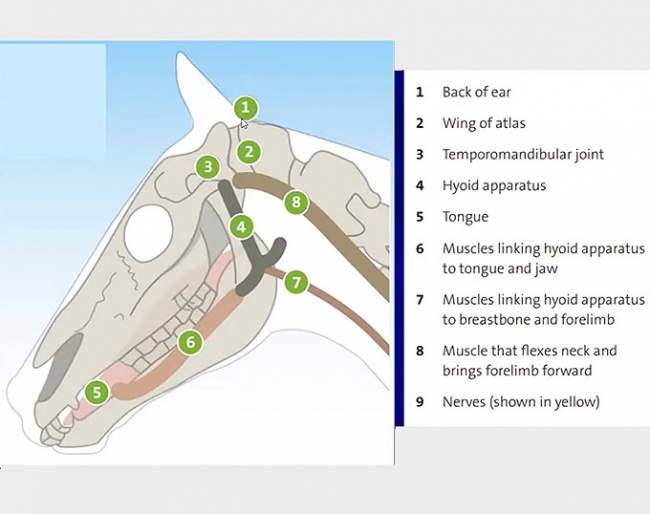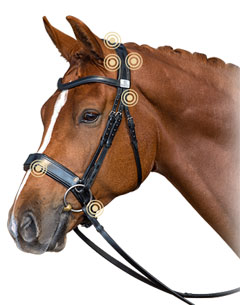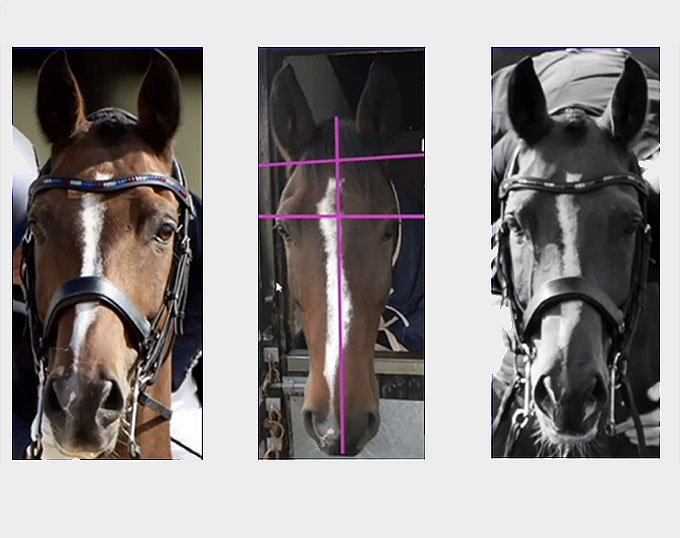
- by Dr Michelle Quinlivan for the Saddle Research Trust
From professional event riders to casual hackers, the bridle is an essential piece of tack, where optimal fit is imperative to ensure inadvertent discomfort or pain is not being experienced by the horse. Experienced veterinarian and scientific advisor to the BEF, Dr Rachel Murray of Rossdales Diagnostic Centre, gave an insightful presentation on this often-overlooked topic, at the Saddle Research Trust’s 4th International Conference in December 2021.
Consider the equine anatomy laying directly underneath the bridle: there are numerous nerves and muscles in horses’ heads which in turn affect many other different structures throughout the body. For example, as shown in the left-hand image, the hyoid apparatus (3), has many important attachments including those to the larynx, tongue, base of skull, and to muscles running to the sternum (breastbone) and scapula (shoulder blade). Also of importance is the TMJ, temporomandibular joint (7), the joint between the mandible (jaw) and the top of skull, which is involved with swallowing and jaw movements. As the outline on the right-hand image depicts, the bridle, particularly the noseband and the area where the browband and headpiece attach, also directly interacts with many nerves which are associated with these anatomical prominences. Despite this impact the bridle has on the horse’s head and body, the calculated consideration taken for correct saddle fitting is often not similarly applied to fitting of the bridle. Concerns regarding nosebands and bits particularly in competition horses has led to some regulations within national federations, however there is relatively little research or discussion regarding other bridle parts or indeed, the bridle as a whole unit.
Dr Murray and her colleagues set about to improve our understanding in this area by conducting a research study to determine areas of peak pressure under the bridle and whether this pressure could be alleviated through corrective bridle design (Murray et al., 2015). Nineteen elite dressage horses were equipped with a variety of well-fitting bridles, which were assessed using pressure mats (Pliance®) alongside gait measurements.

Photo © Fairfax saddlery
Interestingly, these zones of high pressure under the bridle are intermittent, they occur at different phases of the stride cycle due to different ground reaction forces or simply due to natural reflexes such as swallowing. In her presentation, Dr Murray shared some interesting video footage of the data collection for a horse jumping. Here we could see in real-time, how pressure points under the bridle correlate to ground forces experienced during take-off and landing whereas the pressure mat data was flat or negligible while the horse was in flight.
The study also highlighted the effects of various types of bridle parts on these pressure points. For example, a wide headpiece impacts against the font of the atlas whereas buckles create focal pressure points under the headpiece. When looking at different nosebands, the study found that a conventional cavesson was associated with asymmetrical pressures particularly where the leather and buckle occurred. Alternatively, a crank cavesson with buckles on both sides exerted more symmetrical pressure and the side rings acted as articulation points on the bridle which allow different parts to move independently and in synergy with head movements, alleviating pressure. A flash noseband tended to have the highest pressures exerted in most locations, negatively impacting on the horse’s movement. Whereas a well-fitted drop noseband or a Mexican grackle with articulation rings tended to have the lowest associated pressures and freedom of movement.
The pressure data also gave some valuable insights on bridle fit considerations. For example, correct positioning of the noseband relative to the facial crest, which has many nerve endings present. A high fitting noseband, sitting on top the crest (central image), results in very little leeway for movement. If placed lower down so there’s a space between the noseband and the facial crest, it will result in less pressure on the noseband-headpiece unit which the study showed to improve hindlimb movement.
 Having determined in their study which parts of and where the bridle would exert pressure on the horse, the team looked at designing a bridle which would limit these pressures. Fairfax Saddlery came up with a patented bridle design:
Having determined in their study which parts of and where the bridle would exert pressure on the horse, the team looked at designing a bridle which would limit these pressures. Fairfax Saddlery came up with a patented bridle design:
- A. Central lozenge to maintain stability and evenly distribute pressure
- B. Narrow sides of headpiece to avoid the ears and wings of atlas
- C. Splits lowered to increase stability and are symmetrical both sides
- D. Noseband attachments on both sides to avoid midline pressure
- E. Prolite pads to raise bridle off pressure points under the browband
- F. Headpiece and noseband lined with Prolite for comfort
- G. Prolite pad to raise the noseband off the nasal bone
- H. Noseband rings for articulation with head movements
The research group then compared pressure and gait measurements of horses wearing their standard bridle versus the new bridle design. As shown in the graph, the modified headpiece (green bar) significantly decreased the pressure seen with the standard bridle (red bar) and similar results were achieved with the modified noseband. The modified bridle also had a significant effect on horses’ movement, the new design allowing for 4.2% more forelimb protraction, 4.1% more carpal (knee) flexion and 3.5% more tarsal (hock) flexion. When considering the findings, Dr Murray postulated that with a standard bridle we are potentially interfering with important muscle attachments as well as nerve endings in areas under the bridle. This may affect flexion of the head and neck, protraction of the forelimb, tongue movements and attachments of the hyoid apparatus to the sternum and to the scapula.

the horse (photo (c) Rachel Murray)
As Dr Murray commented, “There are real opportunities now to use current knowledge to guide recommendations for bridle fit.” The research she presented demonstrated where we decrease pressure under the bridle, there is a significant improvement in the horse’s movement patterns which can only improve welfare and performance of our horses.
Related Links
The Saddle Research Trust
Fairfax Performance Bridle Granted Two Patents by the GB Patent Office